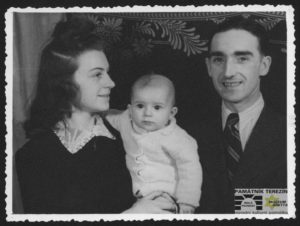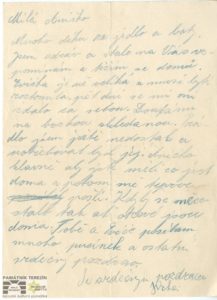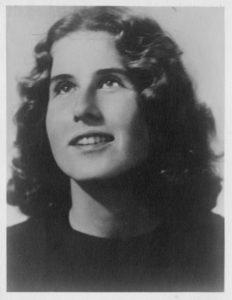Jiri Langer (1916 – 1945)
After his childhood spent in Brandys nad Labem Jiri trained for an electrical engineer and in 1934 he obtained his certificate of apprenticeship. In the second half of the 30s he started a two-year full-time service. He first worked as a telephone operator of Artillery Regiment No. 51 and immediately afterwards, from October 1938 to February 1939, he continued in further active service.
From 1941 he worked in Prague Jawa company. A year later he married a milliner Anna and moved to Lysa nad Labem, where he became the father of a little Eva after 10 months.
At that time he began to work in the resistance. He was in contact with the Kohout brothers from Brandys nad Labem, who he knew from his childhood. Along with them, he set up the illegal organization Stred under the Headquarters of the Revolutionary National Committee and with the help of former military Defence of the Nation. According to the memories of his wife, he often pretended illness not to have to go to work, but to be able to secretly take part in illegal activities instead. He allegedly hid secret materials in a ruined wall in the garden.
For his activities he was arrested in mid-June 1944. First he got to Prague Pankrac prison with a record: preparation of high treason. At the end of 1944 he found himself in the Small Fortress in Terezin. His card said Communist Party, later also the sign XYZ appeared: a symbol used in Terezin to identify prisoners who were assumed to be sentenced to death in case of a trial.
For his apprenticeship he got to so-called workshop court in Terezin police prison, where he helped the civil employee J. Razka from Radosovice. Conditions for survival were slightly better in this court than in other parts of the prison as there was no typhoid here. His cellmate recalled after the war that Jiri sometimes very fervently preached communism on the cell and he had to calm him down because traitors were even among the prisoners.
On the eve of the last Terezin execution Langer got an injection against typhoid. The next morning, on May 2nd 1945, he reported that to the Head of the Workshop J. Razka telling him that he would rather stay in bed that day. However, after lunch, the guards came for him and put him against the workshop wall. Jiri assessed well what was going to happen and tried to escape. Barking dogs allegedly gave him away and Jiri Langer was shot dead during his attempt to flee. He was the only one of all selected for the last execution in Terezin, who the Nazis did not bring up to the execution ground.
Alzbeta Schwarzova (1923 – 1945)
Alzbeta Schwarzova was born to Czech parents in Vienna. In spite of their residence, the family felt Czech in hearts; therefore, after the fall of the Austro-Hungarian Empire in 1918, they registered for the Czechoslovak citizenship. Nevertheless, when Germany implemented “Anschluss” (annexation) of Austria in March 1938, the Schwarzes moved to Czechoslovakia. Their fears were well founded – Elizabeth’s father was a Jew according to the Nuremberg Laws and Elizabeth a Jewish half-breed. In a year, however, they were not safe in Prague either.
In the school year 1942/1943 Elizabeth was attending the eighth year of the Academic Grammar School Na Prikope in Prague 2. Two months before the graduation, she was excluded from the grammar school for racial reasons. Afterwards, she found a job in a factory for chemical paper, where mostly Jews and people of mixed races were working. At that time she was already involved in illegal resistance. She was active in a communist resistance group which was spreading illegal publications. However, they were traced by the Gestapo in August 1944 and Elizabeth was arrested. She spent two and a half months in Pankrac prison in Prague and then was transported to the police prison in Terezin, where she met her mother at the woman’s yard. Her mum was taking a good care of her in the prison, as if Lisa was a little girl again. For example, she knitted her a sweater from wool scraps gleaned from other women prisoners. Both women spent Christmas here. In the spring of 1945 their chances of successful survival were growing because the conditions at the woman’s yard were not as difficult as in other parts of the prison affected by typhoid epidemics.
Elizabeth’s mother returned from Terezin after the liberation, however, Elizabeth was shot dead along with other prisoners during the last execution in Terezin on 2nd May 1945.
Se
Information about the last execution in the Terezin police prison and the others executed there: Hajkova, A.: The last execution in Terezin, Svoboda, Prague 1988




